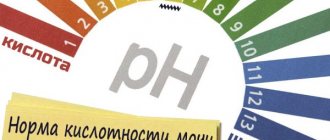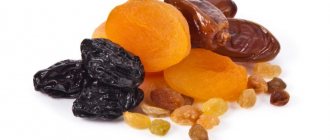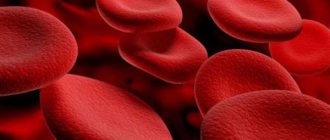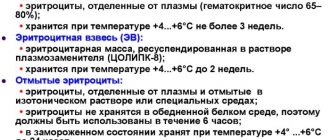Signs of anemia and test orders
Hemoglobin is one of the most important elements of life. With a pathological decrease in its concentration, a disease occurs - anemia. People often call it anemia.
Mild signs of anemia include:
- muscle cramps;
- brittle hair, nails;
- dry, flaky skin;
- attacks of nausea, vomiting;
- pre-fainting states;
As for the acute form of hemoglobin deficiency, this includes the following symptoms:
- acute lack of oxygen in cells;
- fainting;
- the appearance of hallucinations.
All this together entails fatal consequences - a person can be diagnosed with brain hypoxia or atrophy of nerve cells. There is also a high probability of paralysis of the respiratory system.
To determine the number of molecules, a complete blood test is performed, which determines not only the amount of protein (indicated as Hb), but also the average concentration of red cells in the erythrocyte (MCH/MCHC).
Counting useful iron protein in a red blood cell makes it possible to exclude or identify abnormal forms of the substance in the body.
The hemoglobin indicator can also be calculated outside laboratory conditions. For this purpose, there are special devices - hemoglobinometers, which are often used in ambulance teams.
The procedure uses the patient's blood. It is placed in a device with a reagent and thus the indicators of the substance are determined.
Clinical significance of hemoglobin determination
In an adult, the normal Hb concentration depends on gender:
- women 11-14g/% or 110-140 g/l;
- men 12-16 g/% or 120-160 g/l.
For men, the norm is higher, since they have greater muscle mass compared to women.
A decrease in hemoglobin concentration is observed in the following conditions and diseases:
- reduced concentration of red blood cells due to iron deficiency, sickle cell anemia;
- insufficient amount of substances that affect the production of red blood cells (folic acid, vitamin B12);
- red bone marrow disease.
Increased Hb concentration is observed in the following conditions and diseases:
- increased production of red blood cells in red bone marrow disease, malignant neoplasms;
- compensatory increase in the number of red blood cells due to cardiovascular and pulmonary diseases;
- a decrease in the amount of blood plasma as a result of which the number of formed elements increases in 1 liter of biological fluid.
Hemoglobin appears in red blood cells after the loss of the nucleus and the acquisition of cell maturity. The site of red blood cell and Hb disposal is the spleen. The life cycle of 1 cell together is 120 days. After death, iron is released into the blood and supplied to the red bone marrow. With the help of this element, new red blood cells are produced.
Glycating hemoglobin: formation and symptoms
Hemoglobin has a certain “mysterious” feature - it attaches to glucose using a non-enzymatic reaction. This is how the glycolyzed form of the substance is formed. An increase in this form is associated with an excess of glucose in the blood, which may indicate diabetes mellitus.
Thus, according to experts from the World Health Organization, the most effective method for diagnosing diabetes mellitus is an analysis of glycosylated hemoglobin. Indicators of this form of hemoglobin can be determined using a biochemical test of blood taken from a vein.
The purpose of this test is to determine the level of glucose in the blood, which binds tightly to hemoglobin, thereby blocking the ability to transport oxygen through the cells.
Blood testing for glycated hemoglobin is a very important test, as it makes it possible to accurately identify diabetes mellitus (or the absence of it) and help determine the most effective method of treating the disease.
Little secrets
In order to increase hemoglobin in the blood, you need to know the reason for its drop, just in case. You can consume foods that increase hemoglobin (iron, B vitamins) as much as you like, but if they are not properly absorbed in the gastrointestinal tract, then you may not achieve success. Most likely, first you will have to undergo a set of examinations, including the very scary and unloved FGDS (fibrogastroduodenoscopy) in order to exclude pathology of the stomach and duodenum.
As for products that increase hemoglobin, this also has its own nuances. Many plant sources are rich in iron (pomegranate, apples, mushrooms, seaweed, nuts, legumes, melons), but humans are naturally a carnivore and absorb Fe well with proteins, such as:
- Veal;
- Beef;
- Hot lamb;
- Lean pork (by the way, lard, whatever you season it with, will not add iron);
- Chicken is not very suitable, but goose and turkey can easily pass for foods that increase hemoglobin;
- Chicken eggs are low in iron, but contain a lot of vitamin B12 and folic acid;
- There is a lot of iron in the liver, but it is there in the form of hemosiderin, which is practically not absorbed (!), and we should not forget that the liver is a detoxification organ, so you probably shouldn’t get too carried away.
What can help the absorption of necessary substances? Here you really need to look carefully. So that the efforts and money spent on the diet are not in vain, and that home treatment yields good results, we must remember some features of dietary nutrition for anemia:
- Ascorbic acid greatly promotes the absorption of iron from other foods, so citrus fruits (oranges, lemons) will complement the diet well and help raise hemoglobin at home.
- Of the side dishes, buckwheat is the best way to increase Hb, millet porridge and oatmeal are good, but you don’t need to add butter and margarine, they still contain almost no iron.
- It is not very useful to wash down lunch with strong tea, it inhibits the absorption of iron, but a rosehip drink, cocoa (without milk) or dark chocolate will complement an iron-enriched meal well.
- Cheeses, cottage cheese, and milk should not be consumed simultaneously with foods that increase hemoglobin; they contain calcium, which interferes with the absorption of Fe.
- Small (!) doses of dry red wine help to raise hemoglobin at home (this is prohibited in hospitals), but the main thing here is not to overdo it, because it will have the opposite effect, and even better, go to the pharmacy and buy hematogen, which is sold there in the form of toffee: both tasty and healthy.
Meat, buckwheat and rosehip decoction are, of course, wonderful, but only in cases of mild anemia (up to 90 g/l) and as an adjuvant for moderate anemia (up to 70 g/l), but if there is a pronounced form, then you definitely can’t do without the help of iron-containing drugs. Patients do not prescribe them to themselves, because, due to the development of complications and undesirable side effects (iron deposition in organs and tissues - secondary hemachromatosis), treatment requires constant laboratory monitoring and medical supervision.
Regarding other forms of anemia, it should be noted that it probably won’t be possible to increase hemoglobin at home with the help of foods and folk remedies; the underlying disease must be treated, and in this case it is better to trust a doctor.
Indications for testing
To determine the level of this substance, 3 cc is taken from the patient. blood from a vein. Blood sampling can be carried out at any time of the day and not necessarily on an empty stomach - there is no significant difference in the results.
The main indications for testing are:
- Diagnosis of diabetes mellitus;
- Identification of the level of compensation for a given disease
- Additional research during a glucose tolerance test (prediabetes, low-grade diabetes).
Another indication for testing to detect diabetes is glycated hemoglobin in women who are in a state of gestation (pregnancy).
How to take a blood test for hemoglobin
To donate blood, no special preparation is needed, but there are rules that should be followed. Obtaining the most reliable result depends on them:
- hemoglobin test is taken in the morning on an empty stomach;
- the last meal is taken 10-12 hours before blood sampling;
- on the eve of going to the laboratory, it is recommended to avoid heavy physical labor, strenuous training, and stressful situations;
- Fatty foods and alcohol, which distort the data, must be eliminated from the diet within 24 hours.
To carry out the procedure, venous or capillary blood (from a finger) is taken. For prevention purposes, it is enough to undergo a test for hemoprotein levels once every 2-3 years.
Permits
| Hemo_Control |
| Registration certificate |
| 11/10/2008 No. FSZ 2008/02911 “System for measuring hemoglobin level HemoControl with accessories” |
| 04/20/2011 No. FSZ 2008/02908 “Consumables and accessories for the HemoControl hemoglobin level measurement system” |
| Additional documents |
Quo-TestProductsLactate Scout 4
from 100rub to 5999,000rub
O was founded in 2004 as the exclusive representative of EKF - diagnostic GmbH [Germany]
Results of a special assessment of working conditions (SOUT)
Diet for low hemoglobin
To increase hemoglobin, it is recommended to consume more foods that contain iron:
- buckwheat porridge
- beef liver
- pomegranate
- beets
- carrot
- seafood
- apples
- beef
- grape
The diet should be varied and nutritious; you do not need to consume only those foods that contain a lot of iron. Also, you need to take into account that calcium can complicate the absorption of iron by the body. Therefore, the consumption of eggs, fermented milk and dairy products must be reduced.
Determination of the amount of hemoglobin using the Sali method
The method is based on the property of iron-containing protein to transform into hematite chloride under the action of hydrochloric acid. The Sali technique is considered a non-invasive intervention.
The intensity of the color of the liquid is directly proportional to the concentration of hemoglobin in the blood. During the study, the chlorhemin solution is diluted with distilled water to the standard color spectrum.
Important! It is worth noting that hemoglobin according to Sali is not widely used in the Russian Federation.
The method used to determine hemoglobin levels is commonly called the “Sali hemometer.” Another name for the modern method of determining hemoglobin according to Sali is hemoglobinometry. This colorimetric apparatus consists of a special tripod, which has three sockets.
The side nests hold two bottles with substances. The middle socket of this device is necessary to accommodate a numbered glass beaker. The graduated beaker has a scale with graduations that measure the amount of iron-containing peptide compound in grams per deciliter (g/dL). During a clinical blood test, a special pipette is used to hold water and stir the contents of the bottle.
When carrying out a complete analysis using the Sali method, first a 0.10% solution of hydrochloric acid is poured into the flask. Then the research material is taken from the fingertip into a pipette up to o. Subsequently, the pipette is wiped with sterilized cotton wool and placed in a beaker with HCl solution.
The medical professional will shake the contents of the tube several times and let it settle. Complete chemical transformation of the iron-containing peptide compound in a solution of hydrochloric acid occurs in no less than 10-15 minutes.
After five minutes, the color of the liquid is assessed in a hemometer with standard colors. As a rule, it is darker than in standard test tubes. Using a regular pipette, clean water is gradually added to the solution, alternately mixing the contents and comparing with the standard color. At the final stage, the color of the material should be equal to the standard. After all of the above, measure the liquid level and carry out the appropriate calculations.
On an industrial scale, hemometers are produced that contain exclusively a gram-percentage graduated scale. The normal hemoglobin level for men and women is considered to be 15 g%, or 168 g/dl. But even if certain rules are followed, small errors in measurements are observed. In some cases, different results can significantly distort the data about the disease.











